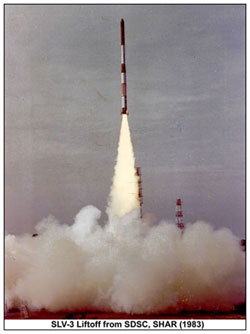SLV3
 The Satellite Launch Vehicle (SLV) project was born out of the need for
achieving indigenous satellite launch capability for communication, remote sensing and
meteorology. SLV3, India's first experimental launch vehicle, was capable of placing 40 kg class
payloads in Low Earth Orbit (LEO). It was an all solid, four stage, 22m tall vehicle, weighing
17 ton. The first experimental flight of SLV3, in August 1979, was only partially successful.
The next launch on July 18, 1980 from Sriharikota Range (SHAR), successfully placed Rohini
satellite, RS-1, into the orbit, thereby making India the sixth member of an exclusive club of
space-faring nations. SLV3 employed open loop guidance with stored pitch programme to steer the
vehicle in flight along a pre-determined trajectory. Two more launches were held in May 1981 and
April 1983, taking Rohini satellites carrying remote sensing sensors into orbit.
The Satellite Launch Vehicle (SLV) project was born out of the need for
achieving indigenous satellite launch capability for communication, remote sensing and
meteorology. SLV3, India's first experimental launch vehicle, was capable of placing 40 kg class
payloads in Low Earth Orbit (LEO). It was an all solid, four stage, 22m tall vehicle, weighing
17 ton. The first experimental flight of SLV3, in August 1979, was only partially successful.
The next launch on July 18, 1980 from Sriharikota Range (SHAR), successfully placed Rohini
satellite, RS-1, into the orbit, thereby making India the sixth member of an exclusive club of
space-faring nations. SLV3 employed open loop guidance with stored pitch programme to steer the
vehicle in flight along a pre-determined trajectory. Two more launches were held in May 1981 and
April 1983, taking Rohini satellites carrying remote sensing sensors into orbit.
The successful culmination of the SLV3 project paved the way to advanced launch vehicle projects such as the Augmented Satellite Launch Vehicle (ASLV), Polar Satellite Launch Vehicle (PSLV) and the Geosynchronous satellite Launch Vehicle (GSLV).